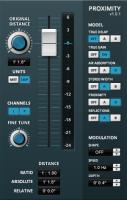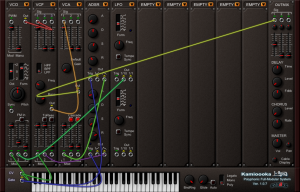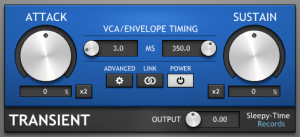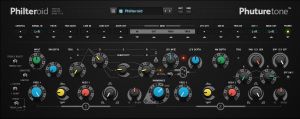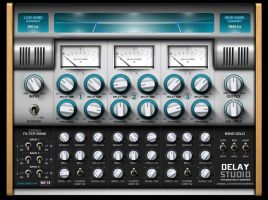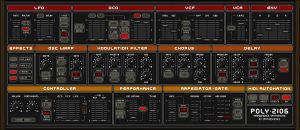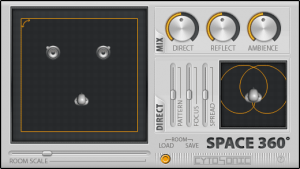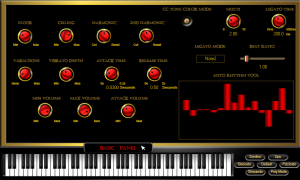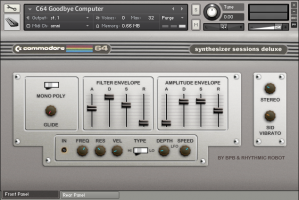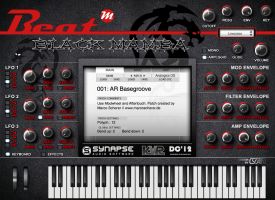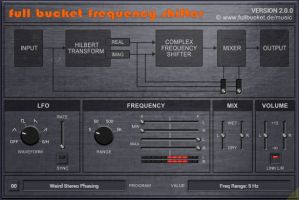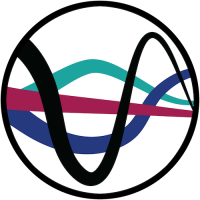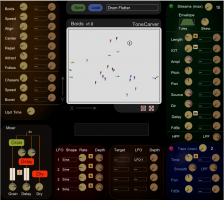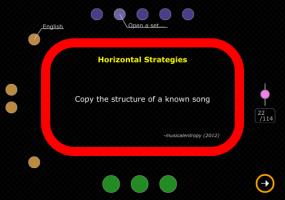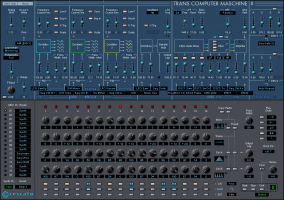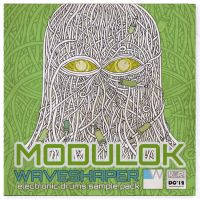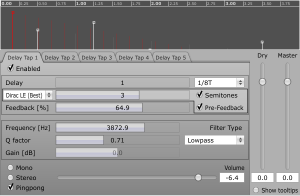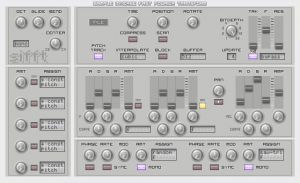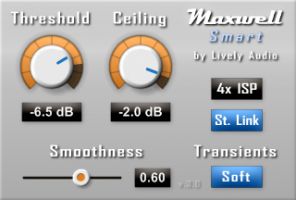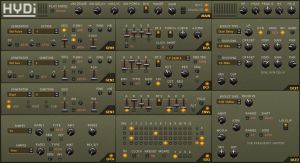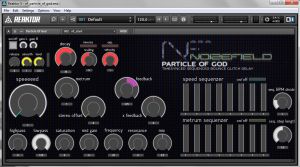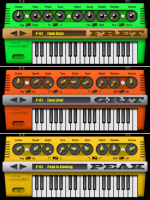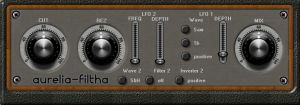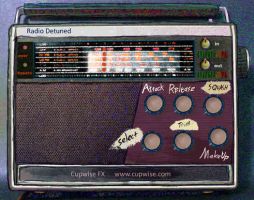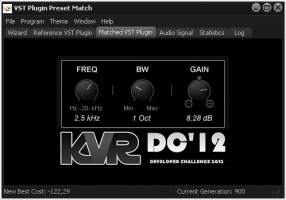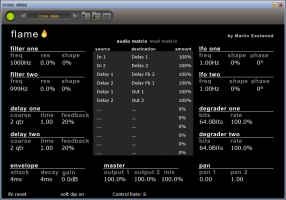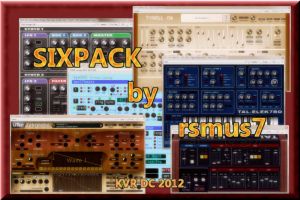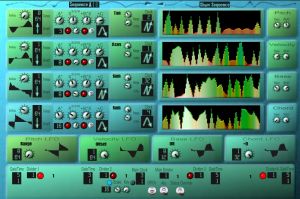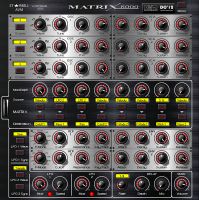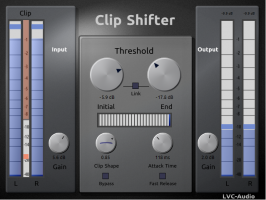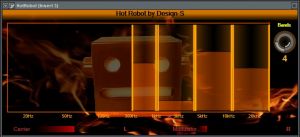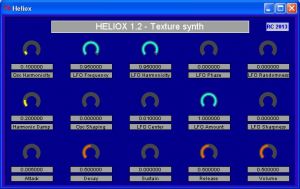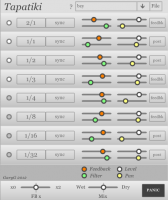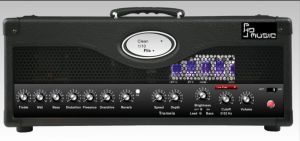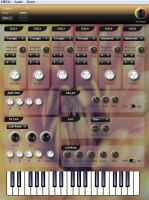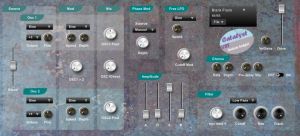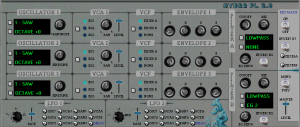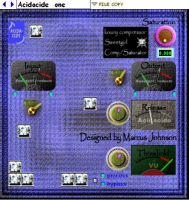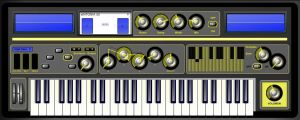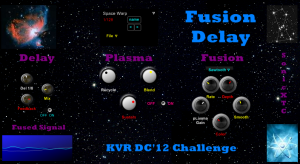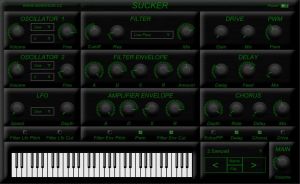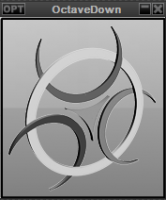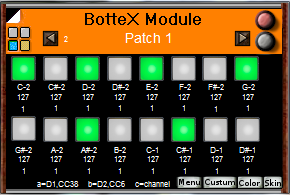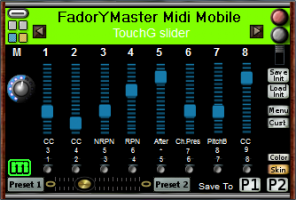
KVR Developer Challenge 2012
Welcome to the KVR Developer Challenge 2012, the fourth free-for-all audio plugin / audio application / soundware design event!
The Winners
There was a clear overall winner this year, with almost twice as many points as the second placed entry. It was ThrillseekerXTC, a contemporary exciter built around a true parallel analog style equalizer design, by Variety Of Sound who wins 30% of the prize fund as the top Windows entry. Variety Of Sound actually won the last DC back in 2009 with FerricTDS - Tape Dynamics Simulator.
Overall second place goes to Proximity, an easy to use distance "pan-pot" based on several psycho-acoustic models, by vladg/sound, who wins 30% of the prize fund as the top Mac OS X entry.
In third place is Kamioooka, a polyphonic Full-Modular synthesizer with patch cable system, by g200kg, who wins 20% of the prize fund as the best of the rest.
The highest placed Soundware entry was The Total Composure Orchestra, a full orchestral sample library created using only samples that are in the public domain, by Total Composure, who wins 10% of the prize fund.
The final 10% wild card random selection will be announced next week.
Read the full DC12 Winners Announcement here
KVR Developer Challenge 2012 Entries
All
Entries
55
Plugin / App
49
Plugin / App
7
Soundware
6
by Variety Of Sound
Bringing mojo back – Thrillseeker XTC is a contemporary exciter build around a true parallel analog style equalizer design. ThrillseekerXTC is all about adding weight, vibe and attitude back to the sound. It delivers all the character of an analog signal path and provides what digital processing usually is hard pushed to, including a rich low-end experience and that vibrant 'expensive' top-end.
At a glance:
- A unique take on a parallel analog equalizer design which includes full control about sonic color and mojo.
- Transient based processing to revive energy and vibe.
- Made for musicians and engineers to pleasingly enhance audio during the mixing or mastering stage.
Specification:
- Three parallel coupled equalizers containing three stateful saturators.
- Each based on a sophisticated non-linear and frequency dependent algorithm with memory.
- Pre-selected frequency ranges.
- LOW band: 70-450Hz.
- MID band: 0.8-5kHz.
- AIR band: 3.2-18kHz.
- Two flavors included with different internal gain-staging.
- Black version to mix at rather conservative levels around -18dB RMS.
- Blue version to mix towards hotter target levels.
- Additional analog signal path idiosyncrasies modelled.
- Classic VU style metering as well as loudness unit measurements based on ITU-R BS.1770.
- Mix control for dry/wet mixing and output level control.
- Win32 / VST compatible plug-in with SSE2 assembler optimized signal path.
- Tested and known to work in many VST hosts as well as running jbridge wrapped in 64bit hosts.
by vladg/sound
Proximity is a collaborative effort by Tokyo Dawn Labs and vladg/sound.
This plug-in is an easy to use distance "pan-pot" based on several psycho-acoustic models. The idea is to give mixing engineer a reliable tool which allows him to manipulate the "depth" of several sound sources in a straight forward and convincing manner.
Several models can be combined:
- Distance signal delay by speed of sound.
- Distance gain loss.
- Absorption of high-frequencies in air.
- Stereo width manipulation.
- Proximity effect of virtual microphone.
- Distance based early reflections.
All of them can be turned on and off to taste. Distance modulation options extend the creative possibilities even further. Units can be switched from metric (meters) to imperial (inches).
The plug-in is available in 32 and 64-bits versions for Windows and Mac OS X in VST and AU format.
by g200kg
Kamioooka is a polyphonic Full-Modular synthesizer with patch cable system. You can freely combine modules and make patches. 10 module slots and 7 types of modules (VCO/VCF/VCA/ADSR/LFO/MISC/SEQ) are available.
Available modules:
- VCO : Oscillator, with PWM/FM/Sync functions.
- VCF : HPF/BPF/LPF filter.
- VCA : Amplifier with modulation input.
- ADSR : Two ADSR Envelope Generator.
- LFO : Two LFO with tempo sync mode.
- MISC : Ring modulator/Noise Generator/Sample&Hold/Inverter.
- SEQ : 8 Step Mini sequencer.
ATTENTION
In v1.0.2, the Unique-ID of the 64-bit version is changed for 32/64 patch compatibility. Old patch (.fxp/.fxb) made with 1.0.0/1.0.1(64-bit) may not be loadable (If you want to use anyway, VSTHost/SAVIHost can load forcibly and can be convert to new ID by exporting).
by Sleepy-Time DSP
Transient is a transient processing VST for Microsoft Windows operating systems. It marks the first KVR DC entry by Sleepy-Time Records!
Features include:
- Mono and Stereo compatibility.
- Transient detection and volume processing.
- Manual timing adjustment for transient detection and processing.
- Adjustable filters for transient detection and processing.
- External sidechain inputs
- Mono tracks, accepts mono sidechain.
- Stereo tracks, accepts mono or stereo sidechain.
- Solo attack, sustain, left, and right.
- Adjustable volume range for transient detection.
by Ignite Amps
PTEq-1a is a digital emulation of a famous Vintage Program Equalizer. It has been developed to have all the characteristics of the original hardware, plus some additional features to increase it's versatility.
Every single component on the signal path of the real analog circuit has been taken into account and modeled in the best possible way to match the original sound, keeping an eye to CPU performances and real-time playability at the same time.
Main Features:
- Three bands equalization with analog curve response.
- Dynamic ECC88 / 6DJ8 SRPP tube stage analog modeling.
- Additional selectable frequencies compared to the original design.
- Mono / Stereo processing support.
- Switchable Eq and Tube stage modeling for better CPU usage management.
- Internal oversampling for aliasing reduction.
- Variable Input and Output Level controls.
- Double precision (64-bit) floating point internal processing.
- Fully automatable controls.
by Phuturetone
Philteroid is a dual filter effect, suitable for use on various type of rhythmic sounds (i.e. drums, bass, synth, guitar). Beside pure filter work, Philteroid is also capable of FM, AM and saturation, and can transform plain sound to one with unique character and interesting texture.
Various filter types, from basic (LP, BP, HP, BR) to uncommon ones, can be obtained with filter type blend control and parallel/serial routing of filters. Filters can be synced in eleven predefined harmonic offsets between filter frequencies and modulated internally by audio signal (FM), ADSR envelope, envelope follower, LFO; or trough external input.
Philteroid is also armed with various amplitude modulation sources and can be used as envelope shaper, expander, noise gate, ring modulator.
Features:
- Filters: Two resonant filters with filter type mix controls (LP/BP/HP/Notch/All-Pass), input overdrive and serial/parallel output routing blend control.
- Frequency Modulators: FM, ADSR envelope, envelope follower, external audio, LFO, MIDI (key tracking).
- Amplitude Modulators: AM, ADSR envelope, AR envelope, envelope follower, external audio, LFO.
- I/Os: 12 assignable input/output slots for internal and external routing of audio/CV and MIDI signals.
- Controls: Automation of all UI controls (except I/O slots) is possible. Double-click reset function.
- Patches: 128 blank user patches. Patch initialize and patch randomize functions.
by Studio Toolz
Minimal System Instruments Delay Studio
Delay Studio from Minimal System Instruments is a powerful and massively creative multiband delay plugin which gives you all of the tools needed to create your perfect delay/echo effect. From weird and wonderful long modulated delays to workhorse multi-taps and analogue inspired echoes the Delay Studio will turn any flat, uninspiring sound into a beautiful sonic masterpiece.
Features:
- 3 fully configurable independent delay bands (Low/Mid/Hi) with complete and accurate control over the frequency width of each band (Frequency Range 0hz to 20,000hz).
- Each band is split in to left and right channels with independent delay time and feedback.
- Comprehensive filter bank section. Each band has its own fully featured filter on both left and right channels complete with cutoff and resonance controls. (Filter types include Low Pass, High Pass, Band Pass, Peaking, and Band Reject). Each filter can be modulated using the multimode LFOs which can also be tempo synced or free running. A total of six filters and six LFOs.
- Built on an accurate crossover algorithm. As with the rest of our plugin range, we model our algorithms on actual physical analogue hardware to achieve the most accurate sound possible.
- VU meters on all bands for visual monitoring.
- Input and Output level controls allow easy attenuation of both the incoming and outgoing audio signals.
- Full automation and controller mapping. All parameters in Delay Studio can be easily mapped to any MIDI controller or MIDI keyboard for complete tactile real-time control. All parameters are designed to be fully automated in all DAWs.
- Balance control to accurately modify the position of the sound in the stereo field.
- Logical and easy-to-use user interface. Minimal System Instruments products are specifically designed to enhance our user's workflow. We intentionally place all parameter controls on the front end of the GUI to make modifying sounds a breeze (No hidden menus or parameters here!).
- Low CPU usage. Our code is fully streamlined and optimised to make Delay Studio as efficient on your resources as possible.
Delay Studio is a plugin that invites creativity and experimentation.
System Requirements
Delay Studio is a VST plugin that runs on Windows based PC's using a suitable VST host or DAW. Our plugins have been fully tested within Ableton Live, Adobe Audition, Cakewalk Sonar, FL Studio, Energy XT, Presonus Studio One, Renoise, and Cubase.
Version 1.01 Change Log:
- Issue where the low band slider could not be dragged has been fixed.
by Xtant Audio
The Total Composure orchestra (TCO) is a full orchestral sample library created using only samples that are in the public domain. Total Composure is the first to offer such a library exclusively for the Kontakt format; making use of Kontakt's scripting capabilities to greatly enhance the playability, realism, and functionality of these public domain samples.
The scripting aims to provide similar functionality across the different instrument groups, whatever the instrument; while more specific settings play to the strength of each instrument.
Most of the instruments only contain one set of samples per articulation, and some only have one recorded dynamic layer – this is one of the many limitations we have found with using public domain samples. We have overcome these issues using a variety of physical modelling techniques that enhance the audio material. Using dynamic filters and intelligent repetition scripting we have removed the limitation of single dynamic recordings and solitary sample sets.
Although we have put a lot of work into this product it is important to remember that at its core are the samples provided free of charge by a small number of people. Total Composure has gathered these samples from various locations and brought them all to one place where they can be used together. There are over 1500 samples in this library totalling more than 1.5 GB but we have used Kontakt's lossless compression to crunch the size to less than 500MB.
The TCO is currently available from download.com (CNET):
http://download.cnet.com/The-Total-Composure-Orchestra/3000-2170_4-75807687.html
by Synthescience
The Poly 2106 initially started off as a recreation of a true object of desire from the fashionable 80's that was once part of our studio, but that was just the initial kick that propelled a seemingly more enthusiastic project which culminated into a knob infested creation with a solid vintage backbone. So for a long time we didn't spare ourselves in the effort of breathing life into a machine which is a breed of everything we would like to see in a true performance synthesizer, something close to the vision of our personal nirvana that now we are ready to share to everyone, our only hope is that you too find it as much as rewarding as we did...
by cytoSonic
Space 360 is a straight-forward room simulator and reverb effect. Behind its no-nonsense interface is a complex implementation of three distinct, yet inter-dependent algorithms for the wavefront (Direct), early reflections (Reflect), and late reflections (Ambience). The effect uses "regressive modeling" to accurately synthesize the most important elements of the reverb sound, while using a more CPU-friendly, statistical approach to the less important elements. The result combines the realism of a convolution reverb with the efficiency and flexibility of an algorithmic reverb.
The Space 360 can be used to add spatial "context" to sampled and synthesized sources, to achieve perfectly accurate binaural panning of stereo tracks, to put multiple tracks into the same virtual "room," or to just add that perfect amount of reverb to make the source sit perfectly in the mix.
The Space 360 will not give you those lush halls that decay forever. It will not give any crazy reverse reverbs or unnatural swells. There are plenty other effects that do that well. What the Space 360 offers is a go-to room simulator and reverb that models the minute details of a natural room remarkably well while not eating up all your CPU resources. You don't need a masters degree in physics or a ruler and protractor to achieve perfectly scaled and filtered reflections. All you need to do is move the little speakers and head around and the effect calculates them internally.
Features:
- Regressive modeling integrates all sections of the effect in the most accurate and efficient manner.
- Perfectly scaled binaural wavefront synthesis.
- Early reflections are custom calculated on-demand for realistic spacial cues.
- Adjustable HRTF with scalable polar pickup pattern, focus, and lateral spread.
- Individually adjustable damping properties for each wall of the virtual room.
- Adjustable diffusion, smear (modulation), and lo-cut filter in the reverb tail.
- All DSP has been hand programmed in inline assembly to ensure the utmost efficiency.
- Works at any sample rate.
- Easy, intuitive GUI.
- ONE PAGE user guide.
by Sound Magic
Orchestral Strings One was recorded utilizing the legendary acoustics in the famous Berliner Hall - home of the world class BERLINER PHILHARMONIKER. Our full string orchestra contains 14 violins, 10 Violas, 8 Cellos and 6 Double Basses. Now it's your turn to experience this huge orchestral section as a useful string instrument. Sound Magic has created Orchestral Strings One as a single ensemble complete with the beautiful ambience of this amazing hall. This incredible instrument will quickly become your "go to" string orchestra. No longer will you have to try and build a similar sound with several different string instruments or sections, burning up tracks, RAM, CPU cycles and your valuable time.
Violins, violas, cellos and basses are considered to be nearly impossible to sample into realistic sounding instruments. And the String Ensemble is the holy grail of these string instruments. KVR's Developers Challenge has provided Sound Magic with an opportunity to push the boundaries of our Hybrid Modeling Technology by creating Orchestral Strings One. Our quest for extreme realism not only lets us flex our engineering and computational chops - it gives you an incredibly useful freebie.
If you're familiar with the #2 ranked KVR instrument, Piano One, you know how clean Sound Magic's efforts are. To ensure the highest sound quality possible in our samples, we use top-of-the-line gear such as Brauner Microphones and Neve preamps. Couple this gear with the prodigious Berliner Hall and Orchestral Strings One is able to push the boundaries of realism - with the aid of Sound Magic's Award-Winning NEO Hybrid Modeling Technology, of course.
The NEO Hybrid Modeling Engine offers you the best from both the sampling and modeling worlds. The Authentic Sound of Sampling combined with the Playability of Modeling makes for a string experience that you have to try to believe! No steep
hardware requirements here. Orchestral Strings One takes up less than 200MB of disk space and doesn't overly tax your CPU. The NEO Hybrid Modeling Engine gives you absolute control over every aspect of each string - you can even design your own string! There are nearly 20 controls waiting for you to tweak! Some of you (you know who you are!) just HAVE to dial up the legato and velocity, fiddle with the dynamic response, and play with those timbre differences.
Unlike static samples, modeling technology really brings the Orchestral Strings One
to life. And more importantly, Orchestral Strings One focuses on the continuous flow of melody, not on just a single note. For example, you can progressively transform a sustained note by first adding slow vibrato, then medium vibrato and finally fast vibrato. While doing this, you can also use the expression controller to change from crescendo to decrescendo. This sort of control is just about impossible to achieve with sampled strings.
Orchestral Strings One is very easy to use. You can play with all the parameters on the fly with a MIDI keyboard using key switches and controllers. A keyboard player can easily and freely play our Orchestral Strings One without any difficulty. It's perfect for a live performance.
Features:
- Innovative Sampling technologies put 14 violins, 10 Violas, 8 Cellos and 6 Double Basses into One instrument.
- Neo Hybrid Modeling Engine make the full strings section into 200MB.
- Innovative Key Switch and Controller system makes it ideal for use in live performance.
- Can real-time switch between Spic, Staccato, Pizzicato, Legato, Cresando, Decresando, PFP, Vibrato, Tremolo, Trills and Sordino by Key Switches and MIDI Controllers.
- Fully controllable legato system.
- Auto Rhythm Tool helps you better and quicker play repeated notes on fly.
- Multi Microphone Positions, Player, Audience and Ambience/Room.
- Small RAM usage and Light on CPU.
- Built-in High-Quality Reverb.
- Built in 64-Steps Sequencer enable users to compose their string phrases in a quickest and efficient way.
- Support Add-ons System.
by Distorque
Azurite is a multi-voice chorus with a focus on rich sounds and versatile controls.
Unlike most choruses, Azurite allows for multiple simultaneous voices. Each of these voices has its own delay line that is modulated by a separate LFO. Adding multiple voices leads to a thicker, smoother, and less wobbly tone. It also makes vivid stereo spreading possible with a mono signal. The Voices control chooses how many voices the chorus uses: one, two, four, or eight.
Other main features:
- Stereo or mono operation.
- Colour control emulates vintage analog choruses.
- 2-band EQ.
- LFO tempo sync.
- Feedback control allows for flanger sounds.
- 27 built-in presets.
- Delay time from 0.2ms to 200ms.
- 7 LFO shapes: Sine, Triangle, Sawtooth, Ramp, Exponential, Inverse Exponential, and Random.
- Spread control for stereo widening of a mono signal.
- Control randomizer.
- Other controls: Depth, Speed, Wet Mix, Output, Separation, Dry Delay.
by Bedroom Producers Blog
Commodore 64 Synthesizer Sessions DELUXE is a collection of multi-sampled sounds captured directly from 3 different versions of the Commodore 64 home computer. It is a collaborative project between Bedroom Producers Blog and Rhythmic Robot.
The sample library contains 30 individual instrument patches. These patches cover a range of well known Commodore 64 era video game sounds, as well as some classic synth sounds which were recreated using the SID chip.
Our goal was to capture the true character of the SID chip, from its beautiful analog filter to the gritty digital oscillators. The 30 included patches are only a starting point, from which the users can further sculpt the sounds using the included SFZ, NKI and Zampler mappings.
Technical details
- 30 multi-sampled instrument patches (Kontakt 4 + SFZ + Zampler).
- 1 complete Commodore 64 drum kit.
- Kontakt 4 interface with a custom GUI.
- 411 individual samples (16-bit WAV).
- 132 MB download size.
- 248 MB size on disk.
by Beat
Beat Black Mamba is a powerful bass library. It's based on the Beat Zampler, developed by Synapse Audio for Beat magazine and thus can load sfz files. Design by Cyan.
Key features:
- Sample oscillators with SFZ support.
- Multi-mode filter.
- Three LFOs.
- Three ADSR envelopes.
- Complex modulation matrix.
- Arpeggiator / step sequencer.
- Effect section with overdrive, equalizer, phaser, chorus, delay and reverb.
- Free demo soundbank.
- Additional soundsets available on the Beat magazine DVDs.
- Easy to use.
- Low CPU usage.
by Full Bucket Music
The Frequency Shifter is a software effect for Microsoft Windows (VST2/VST3/CLAP) and Apple macOS (VST2/VST3/CLAP/AU) written in native C++ code. The main features are:
- Frequency shifting up to ±5000 Hz.
- Optional LFO with five waveforms and Sync to Host option.
- Four frequency ranges, three mix modes.
- Linked or individual control for both stereo channels.
- Plug-in supports Windows and macOS (32-bit and 64-bit).
The Frequency Shifter shifts the spectrum of the input signal up or down along the frequency axis. This effect is also know as "Bode Frequency Shifting" or "Single Sideband Modulation"; IMHO one of the most underrated and ignored effects ever.
Do not confuse the Frequency Shifter with a pitch shifter. A pitch shifter multiplies all frequencies of the input signal by a constant factor while a frequency shifter adds (or subtracts) a constant amount of Hertz to (or from) those frequencies. Thus, the harmonic structure of the input signal will not be preserved in the modulated signal, resulting in a raw, inharmonic, metallic, you-name-it sound the more you apply the effect. Even more, if you mix a slightly shifted signal with the original input signal you will get some uncommon phasing sound.
by Solcito Música
As its name suggests, Vintager Toy is a "toy" that modifies the sound to make it old and/or vintage. The processes are trying to recreate the characteristics of the sound that is heard in the sound systems of the past.
It can be used as:
- an "aging" mastering effect for a mix.
- a single track effect to give warmth vintage to instrument, drum or voice.
by Kevin Kripper
Spectrum Analyzer S8 is a multiple-track real time spectrum analyzer. It lets you visualize the spectral content of 8 stereo tracks simultaneously. It works in different ways. That is, via analog or digital inputs, virtual cables or ReWire protocol.You can use it as a frequency overlap detector and actually see which part of the spectrum each instrument uses. The ideal solution for mixing.
- Buy it here.
- M4L version.
- To see S8 in action you can watch an HD Video Tutorial made with v1.0 here
by ToneCarver
The Boids plugin is a hybrid Granular + Delay plugin that features a 2D "Boid" swarm as a set of modulators for the grain and delay parameters. This plugin grew out of an interest to accomplish two different goals:
- Finding a way to manage grain swarms visually.
- Creating delay-based ambiance that has subtle, not quite random, variations.
The Boid Swarm represents a set of flocking boids (a boid is a "Bird Android" - see Craig Reynolds work: www.red3d.com/boids). There are a few simple rules that each boid uses to determine where it will fly to on the next swarm advance. These include rules for how fast to fly, how near to fly to other boids, how strongly to move to the center of the flock, how strongly to follow a leader boid, and how strongly to match the position and direction of nearby boids.
The swarm space that the boids fly in is treated as a 2D coordinate system where the X (horizontal) and Y (vertical) position of each boid can be used to modulate controls. A swarm may contain up to 200 boids.
The plugin supports multiple grain streams and multiple delay taps (up to 200 each). Each grain stream and delay tap is associated with one of the boids in the swarm. The X position, Y position, Radius position and ID number of that boid associated with the grain stream or tap can be assigned to modulate the controls that define how that specific grain or tap will be produced.
For example, the X position of a boid can be assigned to control the pan value for the delay taps. For each delay tap, the X position of the boid associated with that delay tap will determine its pan position in the output stereo field. Different taps will have different pan values depending on the location of the boid associated with the tap. In this configuration delay tap signals will move through stereo positions as the boids move through the swarm space.
Each of the parameters for the grain streams and delay taps can be modulated using the position of the boid associated with the grain/tap (and/or traditional LFO modulators).
by Musical Entropy
Inspiration is an application developed to stimulate the creativity of music composers.
Influenced by Brian Eno's Oblique Strategies, and techniques described in several books about songwriting, Inspiration allows its users to get random, more or less abstract advice that can provide ways to handle the blank page syndrome, new "cooking recipes" to create music in general, ideas to develop or finish your last song, write a lot of music in a short time, take different musical paths...
Considering Inspiration as another software adaptation of Brian Eno's Oblique Strategies is wrong:
- Indeed, those advice items are gathered together like the Oblique Strategies, but also other thematic sets like the Horizontal Strategies from -musicalentropy for example, the Frustrated Songwriter's Strategies, the Advancing Guitarist strategies, and others.
- The advice items are classified and can be filtered with numerous tags, allowing the users to target specific needs at specific moments. Some examples of these tags : musical instruments like the guitar, the drums or keyboards, various abstraction levels, themes like motivation, harmony, rehearsals, sampling, the development of existing ideas etc.
Moreover, a special editor is included, allowing users to create their own sets, with an efficient and ergonomic interface. With this functionality, you can :
- Create your own advice sets, corresponding to your needs, your personality, and the way you work.
- Share your own advice sets with all the users of Inspiration.
- Fill a list of composition ideas, new tracks or concepts you would like to work on in the future.
- Have a work plan for your preferred musical instrument, full of random exercises to do or existing songs to include to your musical repertoire.
- Optimize your 20-songs game sessions, as described in the book "The Frustrated Songwriter's Handbook" by Nicholas Dobson and Karl Coryat.
Anyway, be careful about the various things Inspiration can not do :
- Write some music for you.
- Play any musical instrument for you.
- Take all the credits of the music you have created thanks to its advice.
- Fill a lack of technical competences and/or a lack of musical knowledge.
- Replace experimented musician's advice.
- Replace experimented musicians.
- Force you read how to use Inspiration before having any opinion on its concept.
- Bring the beers for the rehearsals.
Change history
1.1.0 (05-Aug-2014):
- Added a link to copy and paste the current piece of advice.
- Added a timer to pick a new piece of advice every N seconds.
- Added a feature to mark a piece of advice as a favorite, and to access to all the favorite items only.
- Fixed various bugs.
1.0.4 (16-Jan-2013):
- The application saves its state when it is closed, and recall it at start-up.
- Fixed an issue with the justification of labels.
- The text editors in the editor tab are now multi-line.
- Fixed various bugs and English translation issues.
1.0.3 (29-Nov-2012):
- Added new advice sets, included with the application and available on the downloads page.
- Fixed an issue with the randomness of advice items drawing.
- Fixed an issue with the tag selector control in the edition tab.
- Fixed various bugs and English translation issues.
1.0.2 (14-Nov-2012):
- Added new advice sets, included with the application and available on the downloads page.
- Fixed an issue with the use of the mouse wheel on any control in the edition tab.
- Fixed an issue with apostrophes in the edition tab.
- Fixed an issue with the randomness of advice items drawing.
- Fixed colour change issues in the main tab.
- Fixed various bugs and English translation issues.
1.0.1 (09-Nov-2012):
- Fixed size of the author description font.
- Fixed various English translation issues.
1.0.0 (05-Nov-2012):
- Initial release for DC-12.
by Polygon Audio
Sound Rider is a 3D visualizer that gives you the ability to navigate a 3D representation of a sound signal in your DAW. As well as the traditional horizontal frequency scale and vertical decibel scale the 3D aspect provides a time axis into the screen.
Sound Rider was written for entry into the KVR Developer Challenge 2012.
Sound Rider Main Features:
- High resolution 3D Visualizer.
- Navigation of the waveform with control of position and orientation in 3D.
- Written from scratch in C++ for 64 bit and 32 bit windows.
- User views can be stored.
- Averaging and peak display.
- User peak values can be stored.
- Position and orientation can be automated.
- Includes a 2D view with statistical output.
- 3 Rendering modes: Solid, Wireframe and Points.
- Axis that can be moved in the Z plane for clear measurements.
- Peak and RMS meter.
- Settings can be altered to change key controls, smoothing, frame rate, ballistics etc.
- Interpolation - the faster your machine the smoother the ride.
by Cescato Musiktechnologie
Trans Computer Maschine is a semi-modular Vintage Lead Synthesizer + Pattern Sequencer, firstly modelled after two legendary synths and a custom analogue sequencer from Germany:
-
3 Multi-Oscillators with Sawtooth, Triangle, Saw-Triangle and variable Pulse shapes. True analogue behaviour feat. accurate upper harmonics, phase isolation and drift.
-
Color adjustable Noise Generator.
-
3 mode Ring Modulator.
-
Advanced Sample/Hold section.
-
Selectable 2/3/4-pole resonant LP Filter with auto-oscillation and Bass Recover.
-
HP Filter with bus selection and linked mode for bandpass operation.
-
2 exponential Envelope Generators offering 3 operation modes.
-
Extended modulation routing including Multi-LFO and inverted sources.
-
Unique Sequencer features like 'skip' and 'set' can be played live from MIDI keyboard.
-
Inter-patch Sequencer pattern 'Copy/Paste' feature.
-
Fully MIDI controllable.
-
Fully VST automatable.
by WaveShaper
Modulok is a percussive sample pack made using two semi-modular analogue synths, a couple of vintage synthesizers and a bunch of analogue FX all linked together in a modular fashion.
Crafted by hand with love and care, the goal is to bring out the character of the analogue sound, both smooth and wild, futuristic and retro, raw and advanced, in a big & versatile drum-sample pack, suitable for all kind of music. Analogue but not cliché, this pack knows no boundaries.
Enjoy.
Tech spec:
- Features more than 380 samples for a total size of 153MB:
- 364 one-shot samples, gathered in 4 categories: kicks, snares & lasers, hats & cymbs, percussions & sfx (each category being also sub-divided in 2 sub-categories for a quicker browsing);
- 23 loops of analogue drones and textures for your audio production;
- 24-bit, 48kHz stereo WAV files;
- This pack is released for free, as Waveshaper's contribution to KVR DC2012.
Please visit this page to download it : waveshaper.12r.org
Audio demo: http://soundcloud.com/waveshaperkit/modulok-dub
by lkjb
PitchedDelay is a delay that allows the pitching the delayed signal. This can be done within or outside the feedback loop.
Besides the pitch shifting it has feedback, a basic filter in the feedback path for signal manipulation and mono, stereo and ping-pong mode per delay.
The plugin uses JUCE.
Changelog:
1.3.0:
- Updated to new JUCE version.
- added VST3 support.
1.2.2:
- fixed bug with predelay volume.
1.2.1:
- fixed bug with predelay time.
1.2.0:
- added further pitch shift algorithm (from mda Detune).
- added optional Predelay.
- added 1/32th quantisation.
- Windows x64 support (without Dirac LE).
- fixed version, old fxps should be loaded without fxpFixer.
1.1.0:
- added presets.
- added pan/balance.
1.0.2:
- updated JUCE to 2.0.28.
- fixed: Audio Unit channel configuration.
- fixed: avoid oscillation due to pitching by clipping feedback signal.
Sifft VST (Sample + Inverse Fast Fourier Transform) is an open source FFT based WAV player that allows separate control over time and pitch. This simple method of timestretching uses the phase difference between blocks to reproduce accurate pitch at the expense of creating diffusion due to phase being misaligned on stretched/compressed blocks. The result sounds noisy with minor adjustments but reproduces accurate pitch even with extreme modification (e.g. 1024 times timestretching or much more is possible). The sample may be scanned as if it were "frozen". With the inclusion of frequency shifting, Sifft is well suited for experimental sounds and percussion resynthesis.
Features include:
- loads 8, 16, or 24-bit wavs.
- 3 waveform interpolation modes: none (floor), linear, and cubic.
- emulated downsampling to 1 bit.
- a bunch of filter modes (low, band, high, cut, peak in Moog, Simper svf or RBJ biquad).
- curveable envelopes and modulating LFO contours.
Sifft includes the core process as a SEM module for SynthEdit users and c++ source for the process with notes. A selection of other SEMs are included, e.g. envelopes and filters.
by AXP
AXP SoftAmp 3OD
Vacuum Triode Stage simulator.
A single triode stage circuit typical for guitar preamps is captured in this plugin. The model engine is based on a system of non-linear ODEs. Some smart calculation techniques are used to reduce the computational load.
This effect could be used to apply mild tube overdrive to add some presence to your tracks, or you could chain a couple of instances together for a full-blown high-gain overdrive. You may want to throw in some EQ as well to better shape the signal and use a poweramp/speaker simulator afterwards.
The plugin UI has a real-time transfer characteristic plot display. It provides an overview of the things going on inside the tube. It also has a peak-detecting algorithm that will flash a line when the level exceeds 0dB. You can monitor stereo channels separately or at once by clicking the corresponding buttons under the plot display.
16x switchable oversampling is also implemented to reduce the aliasing effects. Please note that for the most time the aliasing is low enough to switch off the oversampling. When oversampling is enabled, the plot display will not be of much use, because of the phase smearing introduced by the oversampling filters. Still good enough for monitoring the in/out levels.
The model has 3 core controls to configure the circuit:
- 3 different triode models: 12AX7, 12AU7, 12AT7.
- 3 different plate voltages: 150v, 250v, 350v.
- 3 different cathode capacitors: 0.47uF, 1uF, 22uF.
The gain/level controls are combined into a single knob that is operated with left and right mouse buttons.
The "Normalize Output" control enables the normalization of peak-to-peak output voltage swing across all triode configurations, particularly different plate voltages. By default it's turned off to reflect the natural triode stage behavior, which could be regarded as a normalized small-signal gain.
Please note that output signal is not clipped at 0dB to let you overdrive chained stages using more that one plugin instance connected in series. Make sure to watch the output level or use a hard limiter somewhere in your signal chain.
Clicking on the SoftAmp logo in the plugin will bring up the "About" window with a version number and contact details.
Thanks to everyone who has voted for SoftAmp 3OD in the Developer Challenge and used it in their work.
Change history:
1.0.6 (15-Sep-2013):
- 64-bit version.
- Fixed memory leak on UI close.
- Size optimization.
- Different stability improvements.
- Added more presets.
1.0.5 (20-Dec-2012):
- Fixed a bug with UI not opening if another instance of the plugin is closed.
1.0.4 (10-Dec-2012):
- Significantly reduced the amount of "clicks" during the parameter change. More user feedback is appreciated.
- Reworked GUI code to fix some drawing problems. The plugin scanning/loading should be come much smoother across different hosts. Thanks to Martin LeFever for reporting this one and helping to narrow-down the issue.
1.0.3 (5-Dec-2012):
- "Normalize" feature wasn't working as intended. Fixed, added description.
1.0.2 (16-Nov-2012):
- Prevented possible floating-point underflow.
1.0.1 (10-Nov-2012):
- Fixed dependency on MS CRT library.
- Changed signal phase to allow external dry/wet mixing.
- Fixed UI buttons half-lit at startup.
- Optimized CPU load (should no longer cause audio dropouts during parameter change) and model accuracy.
- Slightly reduced audible clicks during triode mode/plate voltage change.
1.0.0 (20-Oct-2012):
- Initial release for DC-12.
Installation:
Unzip the archive and put the "AXP SoftAmp 3OD.dll" or "AXP SoftAmp 3OD x64.dll" to
your VST folder. Make sure to select the one appropriate for your system (Win32 or x64).
Notes:
- This plug-in requires the Windows Imaging Component library. It's included in all Windows versions starting with Windows XP SP3. If you are using Windows XP SP2, you can get it as a stand-alone library here: http://www.microsoft.com/en-us/download/details.aspx?id=32
- It is my hobby to develop the VST audio effect models. I'm not getting paid for it and I use my own limited spare time to do this work. If you like my projects and would want to encourage the future work please consider doing anything from the following list:
- Tell your friends about my site and my plug-ins
- Send me audio samples you've made with my plug-ins
- Drop me a line or two with any comments and suggestions
- Make a small donation through my web site.
License:
This software is licensed for an unlimited usage by everyone, including personal,
commercial and scientific applications. You are NOT allowed to modify it (including both the binary code and the copyright information) or sell it, in either stand-alone or
bundled form. The plug-in is provided "as is" without a warranty of any kind. In no event I shall be liable for any damage associated with the usage of this software. I encourage further distribution by sharing a link to the effect web page.
Please send your questions and suggestions to my e-mail or post them on the site.
VST is a registered trademark of Steinberg, GmbH.
AXP SoftAmp 3OD (c) 2012-2013 Alexander Petrov-Savchenko.
by Lively Audio
Maxwell Smart is a transparent true peak limiter / loudness maximizer with look-ahead. It's designed to boost the overall loudness while maintaining transients without audible distortion. Maxwell Smart also has 4x ISP (inter-sample peak) detection to tame the 'invisible' peaks between regular sample peaks.
Features:
- Transparent true peak limiter / loudness maximizer with look-ahead.
- Simple but effective controls to fluently adjust the sound.
- 4x Inter-Sample Peak (ISP) detection, with the same efficiency as 4x linear phase oversampling, but without any of the common downsides, such as additional sound artifacts or heavy CPU-load.
- Compliant with the latest international recommendations for true peak detection, such as those described in ITU-R BS.1770-4.
- 5ms latency (compensated).
- Support for all sample rates between 8kHz - 384kHz.
by TD
Originally developed for DC'12, this is a heavily revamped model - simply called Version 1.3. HYDi can only be described as one thing - Quirky. Like a pre-patched modular, perfect for tweakheads, the modulation section is integrated into most of the effects.
Main Features:
- Generator 1 & 2 : 19x Different waveshapes/processes.
- x-parameter: PW, Morph, Destable, etc. (when available).
- Generator 3 : Sub-divided into 3 Categories:
- Auxiliary : 11x extra waveshapes.
- Noize : 7x types.
- Sub-generator : 5x waveshapes.
- X-Mix Modulation, Ring Modulation, FSS (Frequency Shifted Sub-generator).
- Click Generator.
- 2x LFO: 9x shapes. AM & FM.
- 4x Envelopes: Different shapes, Reset to Zero option.
- DCF - 15 types: (zero-delay-feedback/TPT), Single and Dual types available, dual modes are independently modulateable.
- 4 (x4) Sequencer.
Effects:
- 3x Effects slots - 16x effects in total:
- MFX - Micro Effects:
- Compressor F1, Panda (auto-panner), FSU2, Gremlin (auto-formant), Three Band Resonator.
- DCE 1 & DCE 2:
- Alfa, Chorus, Dual BPM Delay, Dual Shifter, Digital Hell, Theta Flanger, Polar Phaser, SSB Frequency Shifter, Early Reflections Generator, Modulation Reverb, Zero Modulation Reverb, Transgate.
http://soundcloud.com/ichad-c/simple-automation-hydi
100% HYDi.
by Noizefield Instruments
Particle Of God is an ensemble effect for Native Instruments Reaktor. The idea behind this effect is to create a delay where the delay time is accelerated. The single delays are getting faster (or even slower) for each time the delay is repeated. To get a "musical" result, the delay time and also the delay acceleration is synchronized in time and tempo.
Several parameters can be changed in real-time an tweaked by the step-sequencers.
There is also an template for hexler touchOSC available.
by Signaldust
Dust Bucket is an experimental dual-path stereo chorus, also capable of rudimentary "thru-zero" flanging and other simple modulation effects. Like a bucket-brigade device, it uses fixed length delays with modulated sample-rate. It does not attempt to be a circuit model however; the delays are true stereo and it is designed for clean sound without any non-linear behavior.
It should take automation of most parameters reasonably well. A fairly fast CPU is recommended.
by Acrobatics
The Minisynth series collection consist of three instruments: FRET, GRIT and PEAK.
As an overall concept, Acrobatics simplified controls and packed implementations to the highest grade to push-up users creativity first and give steady look and maximum usability to the three polyphonic synthesizers. A reasonable set of sounds for each synth is included.
FRET is an accurate reproduction of phase modulation synthesizers of the eighties: reproduces pianos, basses, organs and bells patches with ease, and it can explore wild and spacey atmos using alternative programming.
GRIT is voted to pulses, PWM and organ-like sounds: uses a proprietary mix of phase distortion principles in order to produce its sounds. It is the dirty of the family, watch out for massive aliasing and punchness.
PEAK is the analogue baby of the lot. Classic acid and house tones are at hand. Here the LFO addresses pitch of a clean square or sawtooth waveform with typical Minisynth series advanced modulation extras.
Common look and feel and standardized location of knobs and switches goes in the direction of helping musician when in a busy musical work, when he/she certainly requires instant access to basic synthesis controls and settings to fit in the mix. The Minisynth series collection is also suitable for educational purposes for its separate interpretations of most important synthesis methods and applications.
by easytoolz
aurelia-filtha is a Fullstereo-Lowpass-Filter-Plugin with following specs:
- Special Low-Pass Filter (known from my easy-muug/Protege Emus.
- LFO 2 with 6 waves (sin/saw/ramp/trigon/pulse and s/h) with manual.
- modulation-time (FREQ) and Depth-potis - Inverter (positive/negative).
- Targets: LFO 1 - Cutoff - Resonance - off.
- LFO 1 with 5 waves (sin/saw/ramp/trigon/pulse) Host-Syncron - Disvisor.
- Inverter and Depth-poti - Target: Cutoff.
- Midi CCs are shown at tooltips in brackets.
- Dry/Wet-poti.
- Update 1.1 - 32 new Patches - and some little fixes.
by Cupwise FX
It's a small but unique suite of effects made from 2 junky old radios, one solid-state (from the 70's) and the other a tube radio (from the 50's). The radios were 'sampled' using technology similar but superior to the common convolution impulses out there. It's called Nebula, and it can capture the sound of what's being sampled at different dynamic levels, and it can also capture some of the distortion, unlike standard convolution.
These effects use a variant of the Nebula tech called 'Acqua', which just means that these are stand-alone effects, and you don't need Nebula to load them (it's built in, basically). The radios were sampled in extreme ways to get some nasty lo-fi effects. Since these were made with the Nebula technology, they will sound different from other plug-ins out there. You should grab them and give them a try! They're free!
by The penultimate stopover
THE PENULTIMATE TRILOGY
...is nothing but a compilation of the most atypical of my works as sound designer and contains:
1) A first library in Apple Loops format of inharmonic sequences mainly inspired by west-African traditional musics, tailored exclusively in complex signatures : 6/8, 9/8, 12/8.
I called it "Subsaharian Ethnotronics".
2) Another library in ACID format of harmonized soundscapes that are focused on specific types of scales : all harmonized background soundscapes without any rhythmic pulsations, ... that can be adjusted by the user into the tonality of his choice, mainly for improvisation, but potentially also arrangement and composition.
I called it "Marred Waters".
3) A Down-sampled version (16/44.1) of a library of exotic Impulse responses created from scratch, also based on specific types of scales and tonalities. ( The original version BTW has been published under DBU signature, down at this page : http://www.dangerousbear.com/dbsig.html )
I called it "Deep Spaces Light".
by Christian Budde
With VST Plug-in Preset Match it is possible to match the settings of a VST 2.x plug-in to a given reference VST plug-in preset for a certain piece of music. By using a metaheuristics DE algorithm, the matching result will improve continuously over time (if matching is possible at all). With the included ASIO VST plug-in it is also possible to match a VST plug-in to an external hardware device.
This tool can be especially useful if you have older tracks, which use particular effects, which are not maintained anymore (e.g. did not yet make the step to 64-bit). Instead of recreating the plug-in's settings by hand, the tool can match the plug-in settings to the reference as good as possible. Not seldom, the same results can also be achieved with much less effort. For example, a graphic EQ setting can be replaced with a set of parametric peak EQ filters.
With the latest version 1.0.4, the example VST Plug-ins that were shipped to demonstrate the program are also available separately. However, please note, that these were not intended to be used outside this program (although it is likely that they work fine). This is due to the fact, that each plugin could not be tested with every host. Also there is no support beyond this tool.
The VST Plug-in Preset Match as contribution for the KVR Developer Contest will not be developed further, but - if popular enough - will be integrated in the VST Plugin Analyser 2.0. The development of version 2.0 will be partially crowd founded. Further information can be found here.
by Martin Eastwood Audio
Flame is a matrix-based multi-effect. It does not have a set configuration, allowing you to freely route the audio between the different modules however you see fit. This flexibility allows you to create a huge range of sounds and effects.
by rsmus7
this is a bundle of over 300 presets for 6 superb freeware synthesizer plugins:
- Zebralette
- Tyrell N6 v2
- Synth1
- Tal Noisemaker
- TAL-Elek7ro
- TAL-U-NO-62
All are available for PC and Mac. All presets are categorized and work for any style of music, from ambient to dance and electro and ...
by SirSickSik
The Automathico is a MIDI note generator based on looped mathematical calculations.
It's mainly build up from 3 parts:
A fairly small knob-automation recorder which lets you internally automate knob adjustments, a bit bigger part is saved for the rhythmic section and the main part of the display is saved for knobs and selectors for the 6 (almost) identical sequencers.
Two sequencers are for the main base (stable en-harmonic and chord (offset from en-harmonic scaled into the right scale and key).
The other four are for two separate sequencers for both pitch and velocity, so two different patterns can be created together following the same structure (enharmonics and chords).
These 6 sequencers are based on a sample&hold loop in which a series of mathematical calculations are put over the looping values. First a waveshaper, then a parabolic function and finally a math-algorithm like sine, tanh, power, square root. The sequencers all have their own clock-divider and sync-option to enforce recurring patterns and next to this the pitch and velocity sequencers have an extra feed option which allows to feed a value of another sequencer into it's loop via modulating math-functions. As last there is a dedicated LFO for each of the 6 sequencers to modulate one of the parameters, which, in different combinations can yield very interesting results as patterns evolve.
The rhythmic and melodic sections work together to assign the current pitch and velocity values to the note generators in arp-mode. When the switch is down, depending on whether the pitch-sequencer is playing between 0-25%, 25-50%, 50-75% or 75-100%, the most right, middle-left, middle-right, most right midi-note generators respectively will be triggered. As each of these can send on a different MIDI channel, each keyboard-range can be played by a different external synthesizer or sampler (VSTi or hardware).
Together this creates a very dynamic sequencer which can change the mood and rhythm with a single turn of a knob (if you turn the right knob for that of course).
You can use it to control both VSTi or hardware synthesizers or samplers (depending on the MIDI-routing capabilities of your MIDIhost, Cubase and Fruity Loops are for example known to do the job).
For more information, explanation, help and tips&tricks, download the zip and check the help-file.
Next to that, just have fun with it! My pleasure is making music and if I can share that pleasure, I am happy.
(P.S. Below in the comments there is a link to a 16-VST pack with my latest plugins, two which I made to combine with automathico to be able to easier route MIDI channels to different VSTi. The rest I added as these were too big to go directly to my free-VST thread and I wanted these be uploaded anyway)
by Starbell AVM
Features:
- 3 OSC with 7 Waves, Octave Tuning, Fine Tuning, PW, 3 VCA Envelopes.
- 3 Multimode-filter with 9 Types, 3rd Filter is slaved from Filter 2, One Ext Envelope.
- slaved from VCA 3.
- 3 LFO, 2 of them switchable in 5 Waveforms, LFO 3 rate-modulated by LFO 1.
- (fix) and slaved from LFO 2 Panel Settings syncable, 8 x 8 x 21 Modulation.
- Matrix, Wheel Control, tempo-synced.
- Delay, Main Volume, Mono/Poly switch.
- All Controls on the panel with MIDI-Learn-Function.
Works 100% perfectly with the Behringer BCR2000 MIDI Controller!!
Windows only, but not tested with Win7 64-bit.
Tested on Energy XT, Cubase, Reaper, Mulab.
by LVC-Audio
Clip Shifter is a plugin designed to provide saturation and clipping effects to your audio. This can be useful for individual tracks, busses, and overall mixes. The sonic characteristics of the clipping distortion can be altered from hard, brickwall-style clipping, to softer saturation with compression. The threshold controls for Clip Shifter's clipping can be set to dynamically change based on the transient characteristic of the incoming audio.
Clip Shifter is available as a Windows 32-bit or 64-bit VST plugin.
by Design-S
Design-S Hot Robot Vocoder is a vocoder VST effect. It is written in C# and requires .NET 4.0.
What differs this vocoder among others are its bands. You can drag them and resize them as you wish to affect the output sound. You can change number of bands from 4 to 40 by turning the bands knob.
It has a setup package to simplify installation.
by CO2Sound
Heliox is a rather simple experimental synthesizer, with a "no-frills" GUI, capable of "weird" textures and noises, as well as "normal" synth sounds, like pads, leads and basses.
Main features are:
- monophonic, with 30 oscillators bank.
- adjustable oscillators' frequencies, ranging from single frequency to harmonic and non-harmonic series.
- oscillators can be purely sinusoidal, or "shaped" by an adjustable parameter.
- adjustable attenuation factor between successive oscillators.
- 30 LFOs, each modulating amplitude of corresponding oscillator.
- adjustable LFOs' frequencies, similarly to oscillators.
- LFOs can be purely sinusoidal ("bell-like") or "shaped" by 2 adjustable parameters: center and sharpness.
- phase shift between successive LFOs is adjustable.
- LFOs can be periodic or randomly intermittent, with adjustable "density".
- ADSR envelope.
An 8 tap delay effect, designed with simplicity of operation in mind.
Primarily intended for the creation of rhythmic patterns, Tapatiki offers a large range of tempo sync options (2/1 down to 1/64, dotted and triplet options) as well as non-synced delay times of up to two seconds.
Each tap offers level, pan, feedback and a simple filter. This filter can be placed either within the feedback loop or after it. It offers both low and high pass filtering in a single control. Taps can be individually disabled when not required.
A global feedback multiplier can modify the feedback amount of each channel simultaneously from x0 (effectively killing the feedback) to x2. Although Tapatiki has been tuned to prevent excessive feedback loops, a Panic button is also offered to kill runaway feedback.
The controls have been designed for ease of use e.g. sliders that can be dragged from any point, quickly set a controls value with a right-click, no drop-downs, etc.
by Ph D(J) Music
A stereo guitar amp sim VST effect plugin created in SynthMaker CM software. Features:
- Tone controls for treble, mid, and bass;
- Overdrive;
- Distortion;
- Presence;
- Reverb;
- Tremolo;
- Brightness control with lead setting enhancing 106, 254, 1923, and 5447 Hz frequencies and bass setting enhancing 58, 112, 374, and 1187 Hz frequencies;
- Filter with lowpass, highpass, bandpass, band reject, and peaking filters and frequency readout of cutoff;
- Master volume control;
- Bypass on/off switch with momentary "amp power up sound" and glowing amp tube animation.
- Comes with 10 presets and capability to save your own presets.
Knobs by Peppermint. Created with help from the fine people at the SynthMaker forums.
Tested in Sony Music Studio 7, MS Windows XP SP3.
by Reusenoise
A simple drum hit generator,made with some samples from various gear: Tempest, Monotron, a DIY synth, Bazille. Each key plays a single shot sample, from C-1 to G9 (127 single hits in total). Play some random notes and enjoy.
Windows 32- and 64-bit versions.
Thanks to: MaizeSoft, Knobman, Skinman.
Tested in Synapse Orion 32/64 bit, Renoise 32/64 bit, FL Studio 32 bit.
A simple audio demo, everything from KlingKlang except the Kick: klingdemo.mp3
by milomil
This is an aliquote simple synth built from 6-aliquote tuned oscillators. It is an additive/subtractive synth, but oscillators are tuned to aliquote intervals. If aliquote interval is integer, the oscillator is tuned to standard harmonics. Aliquote intervals are typical to natural sound and first instruments (woodwinds, fujara, koncovka, natural drums, ...).
Created by MILOMIL.
by Max Brezhestovski
by Broken Gadget
Catalyst produces hybrid waveforms by taking two oscillators, applying half wave rectification then sticking the results together to form some unusual waveshapes. The focus of the synth is producing some interesting, dynamic waveforms. The concepts may not be that familiar, however the synth has been designed so that each control does something meaningful and useful. There is an in depth manual on the developer's site explaining what's going on 'under the hood' and 64 presets to get you started.
The synth has been featured in Computer Music Magazine: "Different is good and Catalyst is nothing if not different.".
Update, June 2013: The calibration of the control linking the envelope to the filter cutoff has been modified to yield a deeper envelope to cutoff modulation.
The short sound demo is created entirely with Catalyst. No external effects used, just a little mix compression.
by Petrol Limiter
Hydra PL is a digital/analog hybrid style polyphonic synthesizer. Hydra was made to be versatile, but with a focus on gritty pads and other polyphonic patches. It presents a vintage "knob-per-function" style GUI.
Features:
- Three digitally sampled oscillators per voice.
- Three routable ADSR envelopes.
- Two multimode resonant filters (lowpass, bandpass, notch, highpass).
- 8 note polyphony.
- Two fully routed LFOs with delay.
- 4.1 megabytes of sample data.
by Acidacide Media
The Sweet Girl Compressor/Saturation plug-in is a soft stereo processor that will fit right in with your collection of limiters, threshold VST effects, and compressors. Simple to use and easy on the CPU, not to mention that she was knitted from grandmas best fabric. Enjoy.
Designed by Marcus R. Johnson, Acidacide Media for KVR DC 2012.
PIO is a synthesizer features an ADSR, filter MOOG, pitcher, also has a Arpeggiator that is the heart of the synth.
PIO is class exclusive electronic sounds as were the sounds of your games to prinsipio births sounds as computers clasicos.
Pio has 50 song so you can start experimenting.
by SonicXTC
Fusion Delay is a Windows VST designed to create syncopated and evolving delays to any signal. What makes Fusion Delay special and unique is the Plasma section that can be fused with the built in delay signal chain. To our knowledge, Fusion Delay is the only free VST Plugin to use sonic "Acoustic Dispersion" effects. Acoustic dispersion is the phenomenon of a sound wave separating into its component frequencies as it passes through a medium. The "Plasma" section utilizes our acoustic dispersion modeling technology. It can be fused (mixed) with the "Delay" section by using the "Fusion" controls.
Visit www.vstplugin-sonicxtc.com for more information.
by mireksukplugins
Sucker is a 2 oscillators synth.
- 2 Oscillators with Saw, Sine, Square, Triangle and Noise wave.
- Filter Envelope and LFO with modulation cutoff or pitch.
- State Variable Filter with 5 types-Low pass,High pass,Band pass,Band reject and Peaking.
- Effect section-Echo/Ping Pong Delay,Chorus,Overdrive and PWM.
- 20 rewritable presets.
- Fixed bug with fonts.
by PhonicsAudio
OctaveDown is a 32-bit VST effect for pitching audio down an octave.
Prior to this I have released 2 pitch shifters, but with this one, I have built it as low level as possible in Synthmaker. I have run out of time to make it pitch to whatever desired, but one app which I am looking at is playing bass on a regular guitar.
It is a really minimal design, what possibly makes it novel is that it cuts on zero crossings, there is no envelope on the grain's attack, it cuts straight in.
Also it is only 1 sample delay, as the RAM location is written and read at the same time, there is no swapping buffers.
Hope you find a use for it, it can only get better.
I was trying to set the release to be minimal, but had problems with my delay lines causing clicks.
Cheers, Nick
by Midi Mobiles
BotteX is a MIDI plugin similar to FadorY but for only sending a binary message On/OFF. There are different ways to use it. We can use it on mono mode for active an only trigger for example or we can use it in poly mode for activate more trigger simultaneously in any synthesisers or effect processor which could be learn a MIDI message. The interface can be customisable and with different MIDI parameters. A panel option allows other function.
An User manual and a pro version with LFO in the different button and more parameters soon arrive...
Actually, you can use the BotteX in different mode (see Button Interface and change the frame mode). Step Sequencer with FadorY seq, Chord save and trigger with Chord Writing and arpeggiater mode for a 8 notes polyphony Simultaneously.
You can record note with intensity and length from a keyboard if you want it in real time when we use BotteX with FadorY (LFO Time).
by Midi Mobiles
FadorYMaster is a MIDI plugin for sending MIDI messages into a sequencer host (3 layers) in any synthesisers or effect processor which could be learn a MIDI message. The interface can be customisable and with different MIDI parameters. A panel option allows other functions. A morph slider allows to pass gradually from a preset to the other one (P1 and P2). Some occurrence of MIDI mobiles modules (like fadory) can be interconnected for control more than 8 slider parameter.
A User manual can be download here. This user manual is unfinished. Soon the tutorial in English.
Banks .fxb and cubase .xml for the generic périphéric tutorial here.
For improve FadorYMaster, Various sizes can be downloadable... and more option (curves of faders curse, smooth messages, LFO in the different image controls, customisation more easy).
Updated 0.80: reset Push Faders when 'recall patch parameter' Improvement to the Master and active master. soon didactic videos... Sorry. This is a good version.
[...].
Updated 0.83: New option 'filter assignments'. It transform MIDI message in the thru corresponding to the assignments of FadorYMaster in noteoff.
Updated 0.84: The download link wasn't the true FadorY... small correction added. Delete 'text in' parameter Now it's OK.
Updated 0.87: Add LFO in the eight faders and a LFO in the 'morph slider'.
We reach these in a panel LFO with some parameters... click several times to the button 'writing panel' for this.
Enjoy...
More Later :
Updated 1.1.261 :
Correction minor bug and interface skin améliorations. Synchronisation with Poly Key Pressure (Midi Quick). Receive and transmit MIDI clock for synchronise the MIDI mobiles Applications.
'A.I Shadow' Option for use non motorized external controls surfaces.
with the origine writing panel...
Rules, Information, Guidelines, etc.
Show/Hide RulesThe "KVR Developer Challenge" is for anyone who develops Audio Plugins or Applications and, new for this year, Soundware. The challenge is to create and release a brand new free audio plugin, application or sound library / pack / set that will benefit the community at large. Creativity is key, it can be as simple or as complex as you want - KVR members will vote on the entries and pick the eventual winner using whatever criteria they choose to. Anyone can make a donation via PayPal, the prize fund will be distributed to the eventual winners (details below).
Any operating system, any plugin format, a stand-alone application, a sound library - anything that will assist in music making goes! You have three months to get it together - submissions will end on October 31st, 2012. They will all then be hosted for download on the KVR server and released "AT ONCE" for public appraisal and voting!
Although anything goes, you should consider how to appeal to the largest market - things such as open source or being multi-platform may garner a bigger audience, and consequently more votes. This is your call though. Whatever you are comfortable with!
The Basics:
- Anyone may enter.
- Your entry must be an original creation made by you (your team / crew / company / family). Of course you may reuse code / modules / development frameworks, but the actual plugin / application / sound library should be a new, original creation, not just an obviously cut-down subset of a program you have already written.
- Your entry must not break any copyright rules or license agreements - if your entry uses GPL code then your code should adhere to any restrictions imposed by this, for example.
- Your entry must not be restricted in any way that could make it appear to be a demo / trial version for a subsequent "full" release. i.e. It must not be save-disabled or beep every few seconds or nag the user to donate / pay, etc. Your entry should be fully functioning and remain fully functioning forever.
- Your entry may support any operating system(s) in general use for making music: Windows, Mac OS X, Linux, iOS or Android.
- Your entry may support any plugin format, or be a stand alone application / utility, or be a sound / sample library.
- You may use any programming language or development environment (e.g. programming languages such as C++, Delphi, Java, etc. or any of the myriad development applications such as SynthEdit, SynthMaker, Max, etc.).
- Design and testing must be done in private - public beta testing is not allowed as this may affect the voting process.
- During the voting period you may update your entry but updates must be bug fixes ONLY. You are NOT allowed to add new features or rework existing ones during the voting period.
- You grant KVRaudio.com the permission to distribute your entry for download via our server from November 1st, 2012, onwards.
- You grant KVRaudio.com the permission to act on your behalf, without monetary involvement, for your entry to be published and/or publicized in/on written publications with or without accompanied media such as CDs and DVDs, as well as online publications. You may choose to opt out via a written (email) disapproval of such permission at the time of your entry. KVRaudio.com will not seek or make attempts at financial gain by promoting your entries on written or online publications.
How To Enter:
- To enter you will need a KVR Developer Account [get one here - it's free]. If you already manage your products and submit news directly at KVR, you will already have one.
- Access the Developer Control area and add your entry as a new product but remember to also set the DC12 flag. Anything flagged as DC12 will NOT be made live on KVR until the DC12 go live date of November 1st, 2012.
Voting:
- KVR Members will vote for their favourite entries between November 1st - 30th, 2012. Depending on the amount of submissions, the voting period (and consequently the winner announcement date) may be extended for another week or so. All KVR members will be eligible to vote although we may instigate some restrictions at the time of voting - maximum joined date, minimum number of posts, etc. - to help prevent voter fraud.
- Voting will be in the form of selecting a top 5:
- 1st choice will be awarded 5 points.
- 2nd choice will be awarded 4 points.
- 3rd choice will be awarded 3 points.
- 4th choice will be awarded 2 points.
- 5th choice will be awarded 1 point.
- The winners will be announced on December 3rd, 2012.
- The prize fund will be delivered to the winners via PayPal within a week of the winner being announced.
The Prize Fund (Money Money Money)
- The prize will be cold, hard, cash, made up from donations from the KVR community. Donations can be made via PayPal and will be held in escrow by KVR Audio until the winner has been selected. The prize will be paid to the eventual winner via PayPal. We'll endeavor to keep the prize fund total updated here.
- The prize fund will be split:
- 30% to the Windows Plugin or Standalone Application entry with the most votes 1, 2
- 30% to the Mac OS X Plugin or Standalone Application entry with the most votes 1, 2
- 20% to the next highest placed entry
- 10% to the highest placed Soundware entry
- 10% to a wild card random selection (maybe an iOS or Android entry, if we get any!)
- Additional prizes, donated by fellow developers, will also be available and distributed on an ad-hoc basis. If you wish to donate something please contact laura@kvraudio.com
1 These can be the same entry. If it is multi-format and gets the most votes the entrant would receive 60% of the prize fund.
2 Yes we know Linux (and other OS) appears to be overlooked but the Linux (and other OS) userbase at KVR is very small so we'll concentrate prize distribution on the two major Operating Systems for audio production - Windows and Mac OS X. However, in the event of the unlikely situation that the entry with the most votes is for Linux (or another OS) only it will be awarded 30% of the prize fund and the next 40% will be split between the highest placed Windows and Mac OS X entries (20% each) and the "next highest placed entry" will receive 10% instead of 20%.
Good Luck!




